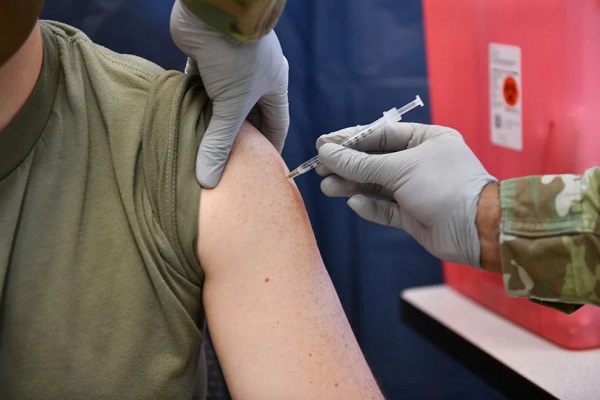Alberta
RDC and Alberta Colleges supporting soldiers

From RDC Communications
RDC joins Colleges Alberta partnership supporting reservists
A group of 12 Alberta post-secondary institutions have signed a memorandum of understanding supporting Canadian Armed Forces (CAF) Reservists who are college employees or students.

The services of Canadian Reservists may be required by the Department of National Defence while having work or study commitments at RDC, or partnered colleges. Leave may be granted under this memorandum, securing their employment and accommodating their studies until they return.
“It is really important if Reservists get called to duty, or have opportunities to train, our institutions support them,” says Joel Ward, RDC President & CEO, on behalf of Colleges Alberta. “There were some formal policies in place but we decided as a group of Alberta colleges to make a strong statement through a MOU, supporting Reservists in our institutions, whether they are students or employees.”
Of the approximately 90,000 dedicated men and women serving in the Canadian Armed Forces, 26,000 are Reservists. About 30 per cent of those Reservists are students. As needed, several accommodations will be available for these learners. Tests and assignments can be rescheduled, and a program may be deferred during a lengthy deployment.
As Commander of 41 Canadian Brigade Group (41 CBG), Colonel Eppo van Weelderen, recognizes the importance and value of this formal agreement. “This collaboration among the Alberta colleges is paramount to continue the development of educated, hard-working and strong leaders for Canada,” he says. “This will help provide the necessary supports to our soldiers as they fulfill their duties serving our nation, in our communities and abroad.”
Forty-one CBG is one of three Army Reserve formations within 3rd Canadian Division. Made up of nine units and a brigade headquarters in Calgary, 41 CBG has seen the number of reserve soldiers increase by nearly 10 per cent the past two years, to approximately 1,600 reserve soldiers garrisoned in Calgary, Edmonton, Lethbridge, Medicine Hat, Red Deer and Yellowknife. Ninety per cent of the soldiers serve part-time.
Carolyn Patton, Alberta Chair of Canadian Forces Liaison Council, views the agreement as mutually advantageous. “This memorandum strengthens the relationship and provides benefits to both parties,” she says. “While serving our country, the Reservists will be able to focus on their duties, and share their skills, knowledge and experiences when they return to their college settings, and communities.”
Maria Anderson, RDC Technician Parts Instructor, has taught at Red Deer College since 2013. She has previously been granted leave by RDC to fulfill her duties as a Reservist. The support from RDC, along with this formal agreement accommodating all Reservists in this group of Alberta colleges, will allow for future development.
“I am grateful to have an employer who encourages my career in the Canadian Army Reserves,” says Anderson. “Knowing that I am supported if I have an opportunity for military training allows me to grow professionally and personally, in ways that benefit my whole community.”
The Reservists’ diverse skillsets provide tremendous value to colleges, and beyond. “The leadership and skills that are developed through military training produces strong employees and students at Red Deer College, and their work benefits the citizens of Canada in many ways,” says Ward. “Reservists are used, not just overseas in combat missions, but also in civil emergencies. Whether it was the ice storm that was in Quebec, or floods, the Reservists are the first to be called so we need to support them.”
To join the Canadian Reserve, contact the nearest armoury in your community. For more information and a list of units in your region, visit the Canadian Army Reserve online.
About Canadian Forces Liaison Council: Canadian Forces Liaison Council is a group of more than two hundred Canada-wide senior business executives and educational leaders, a full-time Secretariat and a national network of Reserve officers. The civilians volunteer their time and efforts to promote the primary Reserve Force by highlighting the benefits of Reserve Force training and experience to the civilian workplace. They also support individual Reservists as well as Reserve units in matters related to employer support. The Council’s mandate is to enhance the availability of Reservists for their military duties by obtaining the support and co-operation of organization leaders in Canada. The Council encourages civilian employers and educational institutions to grant Reservists time off on a voluntary basis, without penalty, to allow them to participate in their military activities, duties and training.
About RDC: For 55 years, RDC has been proudly serving its learners and communities. The College continues to grow programs, facilities and opportunities as it transitions to become a comprehensive regional teaching university during the next three to five years.
This year, RDC will add seven new programs to more than 100 established programs (including full degrees, certificates, diplomas and skilled trades programs). RDC educates 7,500 full-and part-time credit students and more than 38,000 youth and adult learners in the School of Continuing Education each year. The College is expanding its teaching, learning, athletic and living spaces with the additions of the state-of-the-art Gary W. Harris Canada Games Centre/Centre des Jeux du Canada Gary W. Harris, Alternative Energy Lab and construction of a new Residence which all enhance RDC’s Alternative Energy Initiative. Main campus is strategically situated on 290 acres of Alberta’s natural landscape along Queen Elizabeth II Highway. RDC is also proud to serve its Donald School of Business students housed at a downtown campus, located in the Millennium Centre, in addition to housing teaching and learning space at the Welikoklad Event Centre.
For more information on RDC, please visit: rdc.ab.ca
Alberta
Alberta takes big step towards shorter wait times and higher quality health care

From the Fraser Institute
On Monday, the Smith government announced that beginning next year it will change the way it funds surgeries in Alberta. This is a big step towards unlocking the ability of Alberta’s health-care system to provide more, better and faster services for the same or possibly fewer dollars.
To understand the significance of this change, you must understand the consequences of the current (and outdated) approach.
Currently, the Alberta government pays a lump sum of money to hospitals each year. Consequently, hospitals perceive patients as a drain on their budgets. From the hospital’s perspective, there’s little financial incentive to serve more patients, operate more efficiently and provide superior quality services.
Consider what would happen if your local grocery store received a giant bag of money each year to feed people. The number of items would quickly decline to whatever was most convenient for the store to provide. (Have a favourite cereal? Too bad.) Store hours would become less convenient for customers, alongside a general decline in overall service. This type of grocery store, like an Alberta hospital, is actually financially better off (that is, it saves money) if you go elsewhere.
The Smith government plans to flip this entire system on its head, to the benefit of patients and taxpayers. Instead of handing out bags of money each year to providers, the new system—known as “activity-based funding”—will pay health-care providers for each patient they treat, based on the patient’s particular condition and important factors that may add complexity or cost to their care.
This turns patients from a drain on budgets into a source of additional revenue. The result, as has been demonstrated in other universal health-care systems worldwide, is more services delivered using existing health-care infrastructure, lower wait times, improved quality of care, improved access to medical technologies, and less waste.
In other words, Albertans will receive far better value from their health-care system, which is currently among the most expensive in the world. And relief can’t come soon enough—for example, last year in Alberta the median wait time for orthopedic surgeries including hip and knee replacements was 66.8 weeks.
The naysayers argue this approach will undermine the province’s universal system and hurt patients. But by allowing a spectrum of providers to compete for the delivery of quality care, Alberta will follow the lead of other more successful universal health-care systems in countries such as Australia, Germany, the Netherlands and Switzerland and create greater accountability for hospitals and other health-care providers. Taxpayers will get a much better picture of what they’re paying for and how much they pay.
Again, Alberta is not exploring an untested policy. Almost every other developed country with universal health care uses some form of “activity-based funding” for hospital and surgical care. And remember, we already spend more on health care than our counterparts in nearly all of these countries yet endure longer wait times and poorer access to services generally, in part because of how we pay for surgical care.
While the devil is always in the details, and while it’s still possible for the Alberta government to get this wrong, Monday’s announcement is a big step in the right direction. A funding model that puts patients first will get Albertans more of the high-quality health care they already pay for in a timelier fashion. And provide to other provinces an example of bold health-care reform.
Alberta
Alberta’s embrace of activity-based funding is great news for patients

 From the Montreal Economic Institute
From the Montreal Economic Institute
Alberta’s move to fund acute care services through activity-based funding follows best practices internationally, points out an MEI researcher following an announcement made by Premier Danielle Smith earlier today.
“For too long, the way hospitals were funded in Alberta incentivized treating fewer patients, contributing to our long wait times,” explains Krystle Wittevrongel, director of research at the MEI. “International experience has shown that, with the proper funding models in place, health systems become more efficient to the benefit of patients.”
Currently, Alberta’s hospitals are financed under a system called “global budgeting.” This involves allocating a pre-set amount of funding to pay for a specific number of services based on previous years’ budgets.
Under the government’s newly proposed funding system, hospitals receive a fixed payment for each treatment delivered.
An Economic Note published by the MEI last year showed that Quebec’s gradual adoption of activity-based funding led to higher productivity and lower costs in the province’s health system.
Notably, the province observed that the per-procedure cost of MRIs fell by four per cent as the number of procedures performed increased by 22 per cent.
In the radiology and oncology sector, it observed productivity increases of 26 per cent while procedure costs decreased by seven per cent.
“Being able to perform more surgeries, at lower costs, and within shorter timelines is exactly what Alberta’s patients need, and Premier Smith understands that,” continued Mrs. Wittevrongel. “Today’s announcement is a good first step, and we look forward to seeing a successful roll-out once appropriate funding levels per procedure are set.”
The governments expects to roll-out this new funding model for select procedures starting in 2026.
* * *
The MEI is an independent public policy think tank with offices in Montreal, Ottawa, and Calgary. Through its publications, media appearances, and advisory services to policymakers, the MEI stimulates public policy debate and reforms based on sound economics and entrepreneurship.
-

 Also Interesting1 day ago
Also Interesting1 day agoMortgage Mayhem: How Rising Interest Rates Are Squeezing Alberta Homeowners
-

 2025 Federal Election2 days ago
2025 Federal Election2 days agoConservative Party urges investigation into Carney plan to spend $1 billion on heat pumps
-

 Alberta2 days ago
Alberta2 days agoAlberta’s embrace of activity-based funding is great news for patients
-

 COVID-192 days ago
COVID-192 days agoMassive new study links COVID jabs to higher risk of myocarditis, stroke, artery disease
-

 2025 Federal Election2 days ago
2025 Federal Election2 days agoCommunist China helped boost Mark Carney’s image on social media, election watchdog reports
-

 2025 Federal Election2 days ago
2025 Federal Election2 days agoCorporate Media Isn’t Reporting on Foreign Interference—It’s Covering for It
-

 2025 Federal Election2 days ago
2025 Federal Election2 days agoFifty Shades of Mark Carney
-

 Also Interesting2 days ago
Also Interesting2 days agoExploring Wildrobin Technological Advancements in Live Dealer Games





